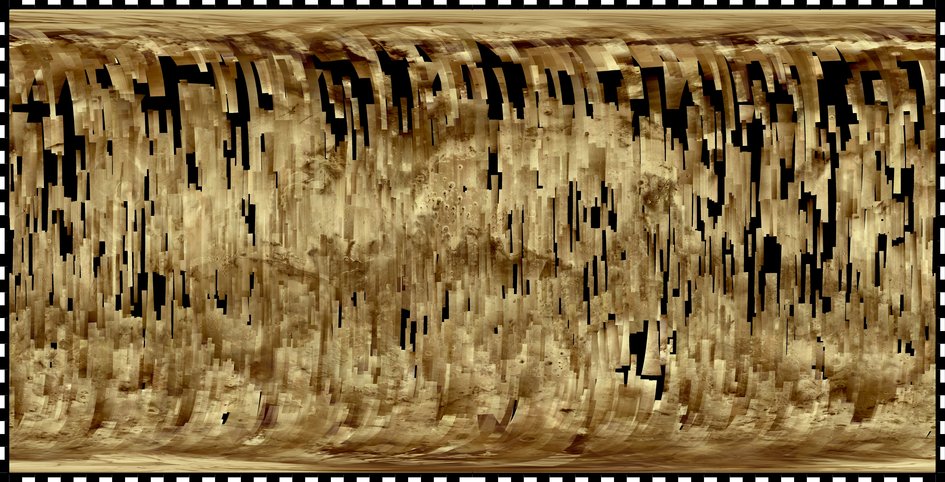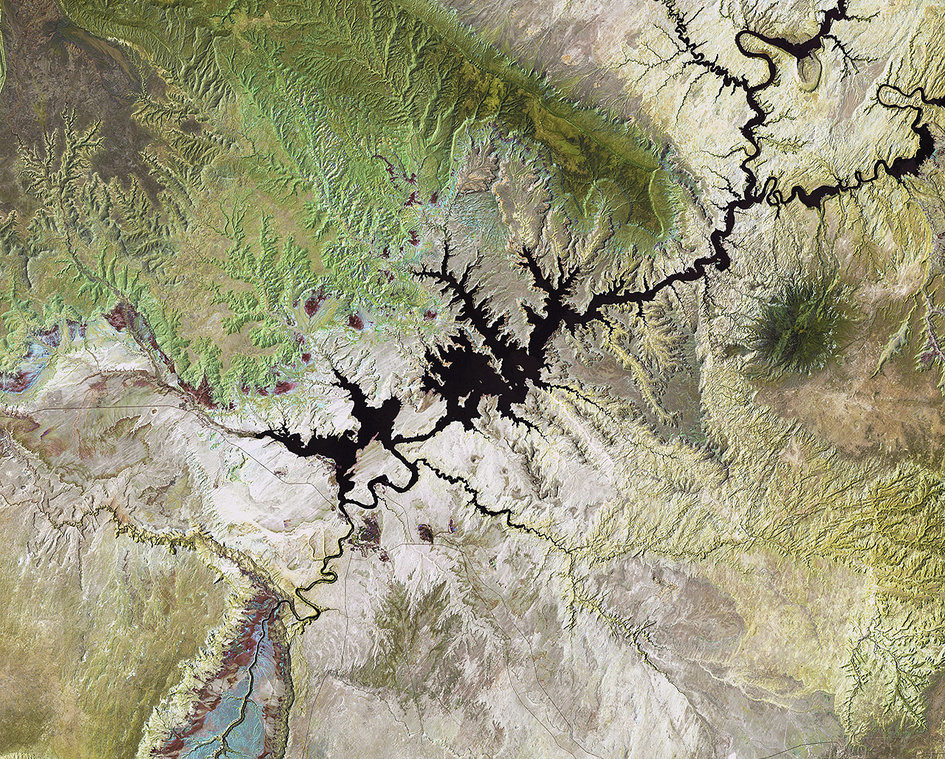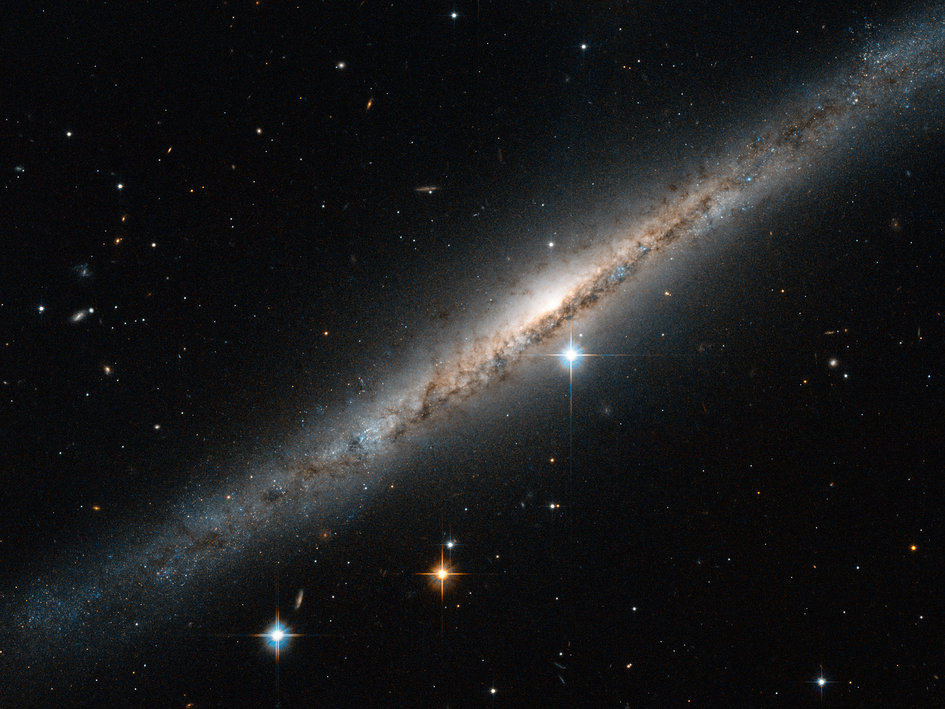
This image combines Hubble observations of M 106 with additional
information captured by amateur astronomers Robert Gendler and Jay
GaBany. Gendler combined Hubble data with his own observations to
produce this stunning colour image. M 106 is a relatively nearby spiral
galaxy, a little over 20 million light-years away.
Credits: NASA, ESA, the Hubble Heritage Team (STScI/AURA), and R.
Gendler (for the Hubble Heritage Team). Acknowledgment: J. GaBany, A
van der Hoeven
Mapping Mars
The latest Mars image mosaic as seen through the lens of the High Resolution Stereo Camera on ESA’s Mars Express.
The mosaic comprises 2702 individual swaths of the martian surface, up to and including the spacecraft’s 10 821st orbit of the planet, which it completed on 30 June 2012.
In total, 87.8% of the surface has been mapped at any resolution, with 61.5% mapped at a resolution of 20 m per pixel or better.
Each white marker around the border of the image represents 10º of latitude or longitude.
This image was released as a Space Science Image of the Week feature on 4 February 2013.
The mosaic comprises 2702 individual swaths of the martian surface, up to and including the spacecraft’s 10 821st orbit of the planet, which it completed on 30 June 2012.
In total, 87.8% of the surface has been mapped at any resolution, with 61.5% mapped at a resolution of 20 m per pixel or better.
Each white marker around the border of the image represents 10º of latitude or longitude.
This image was released as a Space Science Image of the Week feature on 4 February 2013.
Credits: ESA/DLR/FU Berlin (G. Neukum); images processed by F. Jansen (ESA).

Space penguin
This Adélie Penguin is not from outer space but its nearest equivalent
on Earth: Antarctica. The penguin was photographed at Terra Nova Bay,
Antarctica by ESA-sponsored medical research doctor Vangelis Kaimakamis
on one of his stopovers on the long voyage to Concordia research station
in the heart of the white continent.
His voyage took him from Greece to Germany, Singapore, Australia and New Zealand before arriving at McMurdo base in Antarctica. From there he transferred to the Italian Zucchelli Station at Terra Nova Bay, where weather grounded him for a week.
The Adélie Penguin may have been one of the last animals Vangelis sees during his 10-month stay at Concordia because no living being can survive the harsh conditions there. With temperatures as low as –80°C, no outside help can be flown in during the winter and even the Sun does not rise above the horizon for four months.
The closest base to Concordia is the Russian Vostok outpost, some 600 km away. In comparison, the International Space Station is closer to civilisation – astronauts can escape in an emergency and land in under four hours.
Vangelis will run experiments on how people adapt to the stress of living in close isolation. The research this year will be as diverse as studying how the crew’s body posture changes and which materials are more resistant to bacterial growth.
This is one of the many ways ESA is studying human physiology and psychology in preparation for future long missions beyond Earth.
His voyage took him from Greece to Germany, Singapore, Australia and New Zealand before arriving at McMurdo base in Antarctica. From there he transferred to the Italian Zucchelli Station at Terra Nova Bay, where weather grounded him for a week.
The Adélie Penguin may have been one of the last animals Vangelis sees during his 10-month stay at Concordia because no living being can survive the harsh conditions there. With temperatures as low as –80°C, no outside help can be flown in during the winter and even the Sun does not rise above the horizon for four months.
The closest base to Concordia is the Russian Vostok outpost, some 600 km away. In comparison, the International Space Station is closer to civilisation – astronauts can escape in an emergency and land in under four hours.
Vangelis will run experiments on how people adapt to the stress of living in close isolation. The research this year will be as diverse as studying how the crew’s body posture changes and which materials are more resistant to bacterial growth.
This is one of the many ways ESA is studying human physiology and psychology in preparation for future long missions beyond Earth.
Credits: n/a

Lake Powell, United States
This Landsat image from 19 July 2011 shows Lake Powell, a reservoir on
the Colorado River in the southwestern United States. Straddling the
border of the states Utah (to the north) and Arizona (to the south), it
is the second largest artificial lake in the country. The area to the
north of Lake Powell is known as the Grand Staircase-Escalante National
Monument, and covers over 760 000 hectares. Appearing green in this
false-colour image, the Kaiparowits Plateau makes up a significant
portion of the Monument, with the Fiftymile mountain (dark green)
separating it from the Escalante Canyons. Another feature of the
Monument is the Grand Staircase – a sequence of sedimentary rock layers –
part of which is visible in the lower-left corner.
This image is featured on the Earth from Space video programme.
This image is featured on the Earth from Space video programme.
Credits: USGS/ESA

ESO 121-6 seen by Hubble
This thin, glittering streak of stars is the spiral galaxy ESO 121-6,
which lies in the southern constellation of Pictor (The Painter's
Easel). Viewed almost exactly side-on, the intricate structure of the
swirling arms is hidden, but the full length of the galaxy can be seen —
including the intense glow from the central bulge, a dense region of
tightly packed young stars sitting at the centre of the spiral arms.
Tendrils of dark dust can be seen across the frame, partially obscuring the bright centre of the galaxy and continuing out towards the smattering of stars at its edges, where the dust lanes and shapes melt into the inky background. Numerous nearby stars and galaxies are visible as small smudges in the surrounding sky, and the brightest stars are dazzlingly prominent towards the bottom left of the image.
ESO 121-6 is a galaxy with patchy, loosely wound arms and a relatively faint central bulge. It actually belongs to a group of galaxies, a clump of no more than 50 similar structures all loosely bound to one another by gravity. The Milky Way is also a member of a galactic group, known as the Local Group.
Tendrils of dark dust can be seen across the frame, partially obscuring the bright centre of the galaxy and continuing out towards the smattering of stars at its edges, where the dust lanes and shapes melt into the inky background. Numerous nearby stars and galaxies are visible as small smudges in the surrounding sky, and the brightest stars are dazzlingly prominent towards the bottom left of the image.
ESO 121-6 is a galaxy with patchy, loosely wound arms and a relatively faint central bulge. It actually belongs to a group of galaxies, a clump of no more than 50 similar structures all loosely bound to one another by gravity. The Milky Way is also a member of a galactic group, known as the Local Group.
Credits: ESA/Hubble & NASA
ESA
Guillermo Gonzalo Sánchez Achutegui
ayabaca@gmail.com
ayabaca@hotmail.com
ayabaca@yahoo.com
 (1.18 MB)
(1.18 MB)
No hay comentarios:
Publicar un comentario